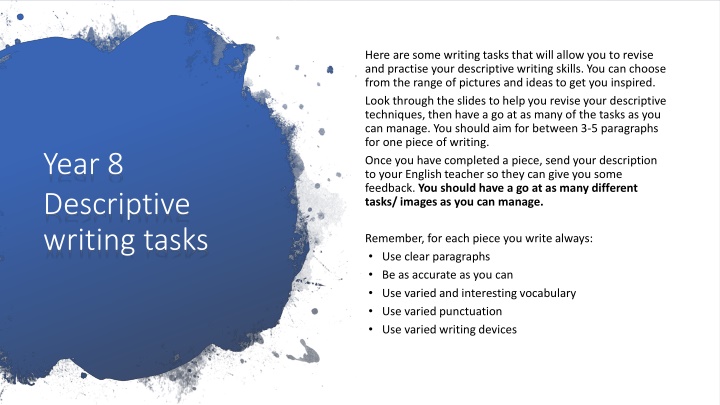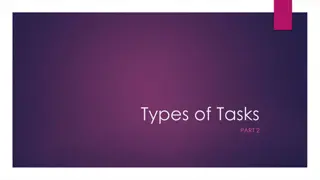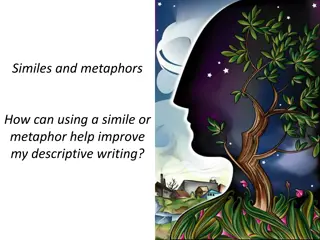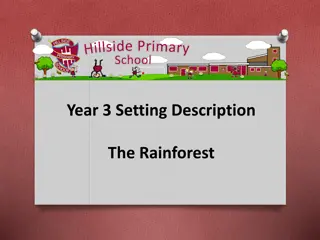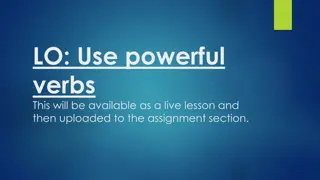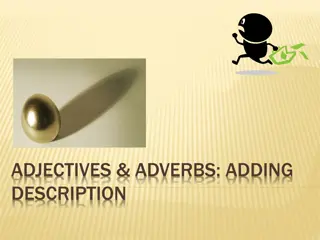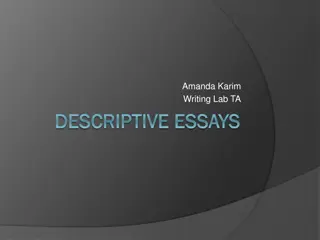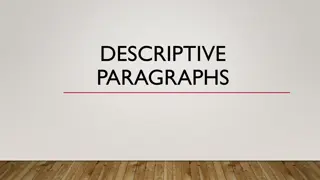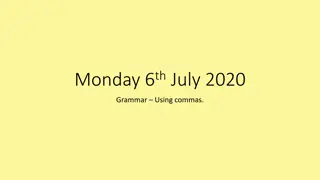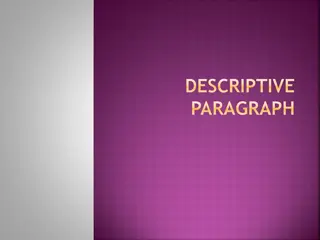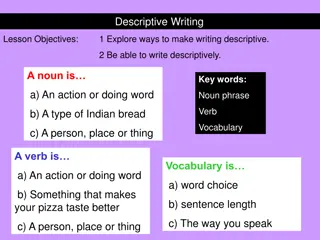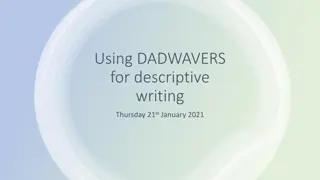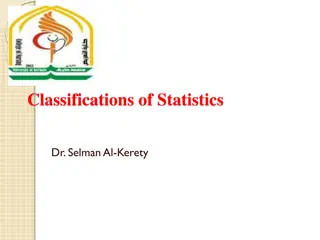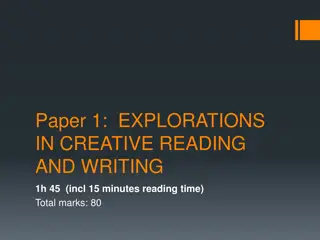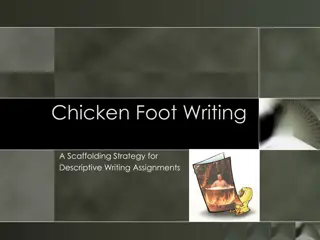Enhancing Descriptive Writing Skills Through Engaging Tasks
Explore a variety of writing tasks designed to enhance descriptive writing skills, including using nouns, adjectives, verbs, and adverbs creatively. Learn about descriptive techniques such as metaphors, similes, and imagery to enrich your writing. Practice choosing precise vocabulary to create different moods and settings, and receive feedback from your English teacher to improve further.
Uploaded on Sep 14, 2024 | 3 Views
Download Presentation

Please find below an Image/Link to download the presentation.
The content on the website is provided AS IS for your information and personal use only. It may not be sold, licensed, or shared on other websites without obtaining consent from the author.If you encounter any issues during the download, it is possible that the publisher has removed the file from their server.
You are allowed to download the files provided on this website for personal or commercial use, subject to the condition that they are used lawfully. All files are the property of their respective owners.
The content on the website is provided AS IS for your information and personal use only. It may not be sold, licensed, or shared on other websites without obtaining consent from the author.
E N D
Presentation Transcript
Here are some writing tasks that will allow you to revise and practise your descriptive writing skills. You can choose from the range of pictures and ideas to get you inspired. Look through the slides to help you revise your descriptive techniques, then have a go at as many of the tasks as you can manage. You should aim for between 3-5 paragraphs for one piece of writing. Once you have completed a piece, send your description to your English teacher so they can give you some feedback. You should have a go at as many different tasks/ images as you can manage. Year 8 Descriptive writing tasks Remember, for each piece you write always: Use clear paragraphs Be as accurate as you can Use varied and interesting vocabulary Use varied punctuation Use varied writing devices
The building blocks of descriptive writing Nouns Ferris wheel Steps Smoke Bandstand Soldiers Clouds Sun Verbs Stood Moved Climbed Huddled Rested Nouns: The objects (things, people etc) in the image you will build up sentences around the nouns. Think about the less obvious objects, too. Adjectives: words that describe nouns. Be ambitious and varied with your word choices. Build up several adjectives for nouns. Verbs: action words. Be ambitious and varied with your choice of verbs. Create lists of interesting verbs for different objects. Use them to create the mood. Adverbs Silently Relentlessly Hopelessly Mysteriously Slowly mesmerisingly Adjectives Tattered Ghostly skeletal Twisted Derelict Proud Adverbs: words that describe the way an action is carried out (often end in ly) which adds detail to your description. 2
Here are some writing devices you can use in your descriptions. Are you familiar with them all? If not, look them up and create a glossary. Detailed / describing words Extended metaphors & metaphors Similes Colour Repetition Imagery Personification/ pathetic fallacy Use a range of these descriptive techniques to describe different nouns in your writing. Tone Imagine with your senses Varied vocabulary / verbs End with impact (you might repeat something from your opening paragraph for example). 3
Choosing Vocabulary for effect Using words that add detail, especially if this is a story, will help to suggest a mood and setting for the reader. Vague words deaden a piece of writing; precise words, full of descriptive energy, bring it to life. Describing a church yard at night to create at tense mood: Bats swooped dangerously close to my head as the haunting outline of the moon glared over the silhouette of the gravestones. The stench of decay hung in the damp night air, as a warning to those that dared to enter Describing a church yard at a wedding to create a positive mood: Doves soared overhead as we bustled from the church doorway. The clouds parted for the beaming sun that warmed the backs of the guests. Confetti and the scent of perfumed flowers filled the air; laughter twirled like ribbons around the bride and groom Setting Mood Example vocabulary City Happy A bright sun glinted from the skyscraper windows Jungle Sad The baboons plaintive cries pierced our hearts The sand burned, the dust stung; but we marched on regardless Desert Determined Small white cloudlets hovered so close to our heads we felt we could touch them Mountains Hopeful Beach Excited Crabs scuttled hither and thither, children squealed in delight 4
How to structure your description 1. Wide angle weather, overall goings on Lots of details about the scenery. 2. Zoom in choose a character to pretend to be, circle them on the image or imagine one if there are no people what are your feelings / thoughts? What are you doing there? Why? 3. Tracking shot/ close up look around you giving close-up details as you move around or observe the goings-on. 4. Action shot something happens to develop your description 5.Wide angle- zoom out again, link back to something at the start, add in a new detail. Think about the final sentence carefully to create impact. Be ambitious: you could always try to use a repeated single sentence paragraph or one word paragraph throughout your writing Think Camera 5
This is a teaching resource that provides appealing, thought-provoking and sometimes rather strange visual images that can inspire your writing. There is a new picture for every day of the year which you can look through. If you click on the arrow at the bottom of each picture, there are writing tasks and the start of a story which you can choose to continue. Have a go! Looking for inspiration? Try this website: Pobble365.com
Choose any of the pictures to set your description in. You should focus on describing things that are part of the scene as if you or someone else is there. Think about the obvious things, then move onto smaller details. Can you create a contrast in one of your paragraphs? Can you include a flashback? Write through someone s eyes but avoid it becoming too much of a story away from your main setting.
Heres another task to try Take a seat somewhere safe (in the house, in the garden, on a walk with a parent etc) and I would like you to just observe the world around you. Make some notes on all of the senses - what do you hear? What do you smell? What colours can you see? Then, I would like you to write a descriptive paragraph based on the world that you can see. Think about using the senses, using ambitious punctuation and vocabulary and also embedding your writing with a range of different language methods. Then, from your imagination, I would like you to write a second paragraph which is the complete opposite to the first paragraph. You will have to use your imagination here to do this! For example, if paragraph one is about a hot sunny day with luscious green fields and birds tweeting, your second paragraph might then be in the middle of a storm, describing the destruction and the fragmentation of the elements. Have some fun with it!
